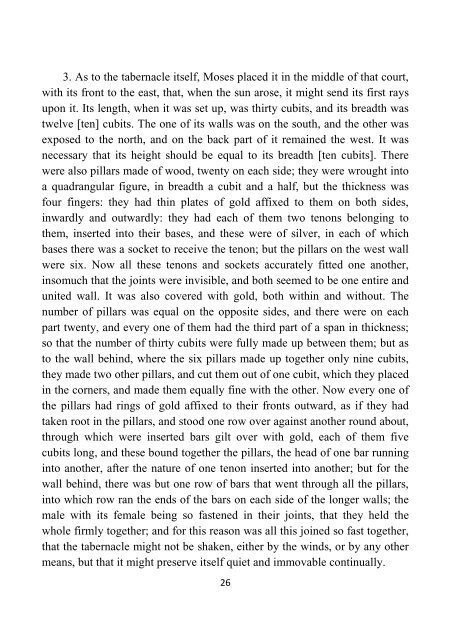From the Exodus Out of Egypt to the Rejection of That Generation - Flavius Josephus
Create successful ePaper yourself
Turn your PDF publications into a flip-book with our unique Google optimized e-Paper software.
3. As <strong>to</strong> <strong>the</strong> tabernacle itself, Moses placed it in <strong>the</strong> middle <strong>of</strong> that court,<br />
with its front <strong>to</strong> <strong>the</strong> east, that, when <strong>the</strong> sun arose, it might send its first rays<br />
upon it. Its length, when it was set up, was thirty cubits, and its breadth was<br />
twelve [ten] cubits. The one <strong>of</strong> its walls was on <strong>the</strong> south, and <strong>the</strong> o<strong>the</strong>r was<br />
exposed <strong>to</strong> <strong>the</strong> north, and on <strong>the</strong> back part <strong>of</strong> it remained <strong>the</strong> west. It was<br />
necessary that its height should be equal <strong>to</strong> its breadth [ten cubits]. There<br />
were also pillars made <strong>of</strong> wood, twenty on each side; <strong>the</strong>y were wrought in<strong>to</strong><br />
a quadrangular figure, in breadth a cubit and a half, but <strong>the</strong> thickness was<br />
four fingers: <strong>the</strong>y had thin plates <strong>of</strong> gold affixed <strong>to</strong> <strong>the</strong>m on both sides,<br />
inwardly and outwardly: <strong>the</strong>y had each <strong>of</strong> <strong>the</strong>m two tenons belonging <strong>to</strong><br />
<strong>the</strong>m, inserted in<strong>to</strong> <strong>the</strong>ir bases, and <strong>the</strong>se were <strong>of</strong> silver, in each <strong>of</strong> which<br />
bases <strong>the</strong>re was a socket <strong>to</strong> receive <strong>the</strong> tenon; but <strong>the</strong> pillars on <strong>the</strong> west wall<br />
were six. Now all <strong>the</strong>se tenons and sockets accurately fitted one ano<strong>the</strong>r,<br />
insomuch that <strong>the</strong> joints were invisible, and both seemed <strong>to</strong> be one entire and<br />
united wall. It was also covered with gold, both within and without. The<br />
number <strong>of</strong> pillars was equal on <strong>the</strong> opposite sides, and <strong>the</strong>re were on each<br />
part twenty, and every one <strong>of</strong> <strong>the</strong>m had <strong>the</strong> third part <strong>of</strong> a span in thickness;<br />
so that <strong>the</strong> number <strong>of</strong> thirty cubits were fully made up between <strong>the</strong>m; but as<br />
<strong>to</strong> <strong>the</strong> wall behind, where <strong>the</strong> six pillars made up <strong>to</strong>ge<strong>the</strong>r only nine cubits,<br />
<strong>the</strong>y made two o<strong>the</strong>r pillars, and cut <strong>the</strong>m out <strong>of</strong> one cubit, which <strong>the</strong>y placed<br />
in <strong>the</strong> corners, and made <strong>the</strong>m equally fine with <strong>the</strong> o<strong>the</strong>r. Now every one <strong>of</strong><br />
<strong>the</strong> pillars had rings <strong>of</strong> gold affixed <strong>to</strong> <strong>the</strong>ir fronts outward, as if <strong>the</strong>y had<br />
taken root in <strong>the</strong> pillars, and s<strong>to</strong>od one row over against ano<strong>the</strong>r round about,<br />
through which were inserted bars gilt over with gold, each <strong>of</strong> <strong>the</strong>m five<br />
cubits long, and <strong>the</strong>se bound <strong>to</strong>ge<strong>the</strong>r <strong>the</strong> pillars, <strong>the</strong> head <strong>of</strong> one bar running<br />
in<strong>to</strong> ano<strong>the</strong>r, after <strong>the</strong> nature <strong>of</strong> one tenon inserted in<strong>to</strong> ano<strong>the</strong>r; but for <strong>the</strong><br />
wall behind, <strong>the</strong>re was but one row <strong>of</strong> bars that went through all <strong>the</strong> pillars,<br />
in<strong>to</strong> which row ran <strong>the</strong> ends <strong>of</strong> <strong>the</strong> bars on each side <strong>of</strong> <strong>the</strong> longer walls; <strong>the</strong><br />
male with its female being so fastened in <strong>the</strong>ir joints, that <strong>the</strong>y held <strong>the</strong><br />
whole firmly <strong>to</strong>ge<strong>the</strong>r; and for this reason was all this joined so fast <strong>to</strong>ge<strong>the</strong>r,<br />
that <strong>the</strong> tabernacle might not be shaken, ei<strong>the</strong>r by <strong>the</strong> winds, or by any o<strong>the</strong>r<br />
means, but that it might preserve itself quiet and immovable continually.<br />
26

















